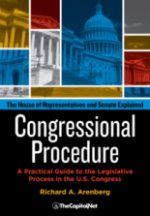From the Congressional Glossary – Including Legislative and Budget Terms
The United States Congress consists of two separate legislative bodies: the House of Representatives and the Senate. Jointly these two separate legislative bodies are referred to as “Congress”.
Congress meets in the United States Capitol building.

Congress, n. A body of men who meet to repeal laws.
— Ambrose Bierce, The Devil’s Dictionary
Article. I. Section. 1. of the Constitution provides: “All legislative Powers herein granted shall be vested in a Congress of the United States, which shall consist of a Senate and House of Representatives.”
Article. I. Section. 2. establishes the House of Representatives, and Article. I. Section. 3. establishes the Senate.
The size of the House of Representatives, currently 435 members, is set by the Constitution (“The Number of Representatives shall not exceed one for every thirty Thousand, but each State shall have at Least one Representative”), and by the Apportionment Act of 1911 (2-page PDF![]() ) (62nd Cong, Sess. I, Chap. 5, H.R. 2983, Pub.L. 62-5, August 8, 1911), in effect since 1913, which established a limit of 433 and allowing for the addition of 2 more seats when Arizona and New Mexico were admitted into the Union in 1912. How the 435 seats are allocated among the states is determined after each decennial census in a process called “reapportionment,” 2 U.S.C. § 2A.
) (62nd Cong, Sess. I, Chap. 5, H.R. 2983, Pub.L. 62-5, August 8, 1911), in effect since 1913, which established a limit of 433 and allowing for the addition of 2 more seats when Arizona and New Mexico were admitted into the Union in 1912. How the 435 seats are allocated among the states is determined after each decennial census in a process called “reapportionment,” 2 U.S.C. § 2A.
The Senate and the House of Representatives Explained (Congress – AP Government Review)
The size of the Senate, currently 100 members, is established by the Constitution (“The Senate of the United States shall be composed of two Senators from each State….”).
The current political composition of Congress is available at CongressByTheNumbers.com.
In the Constitution and in some documents and usage, these two separate bodies are referred to as “the two houses of Congress” or “both houses of Congress”. To avoid confusion, we prefer to use “two chambers of Congress” or “both chambers of Congress” rather than the more formal usage.
The other body: When members of the House and House staff speak of “the other body,” they are speaking of the Senate. When members of the Senate and Senate staff speak of “the other body,” they are speaking of the House.
A “Member of Congress” (MOC) can be a member of the House or the Senate.
At the national level there is only one legislative body formally known as the “House” and that is the U.S. House of Representatives. Currently the House has 435 members, and its members are called “Representative” (Rep.) or, colloquially, “Congressman” or “Congresswoman“.
Currently, there are 100 members of the U.S. Senate, and each member is called “Senator“.
Each “Congress” lasts for two years and is numbered as a “Term” of Congress. For example, the Congress meeting between January 3, 2017 and January 3, 2019 is the 115th Congress. Each term of Congress is divided into two Sessions, each session lasting one year. Being “in session” refers to when Congress is meeting during the session.
For a table showing the terms of Congress from 1789 to the present, see TermsofCongress.com.
‘The Best View In Washington’ From Top Of The US Capitol
For a short list showing the major differences between the House and the Senate, see CongressByTheNumbers.com.
The Constitution provides that the Vice President of the United States is also the President of the Senate (Article I., Section 3.). Most of the time, a senator from the majority party in the Senate serves as the Senate’s presiding officer. When senators are speaking on the Senate floor, they address the presiding officer as “Mr. President.” In the contemporary Senate, when a female Senator is presiding, she is addressed as “Madame President.”
In the House, the presiding officer is the Speaker of the House (Article I., Section 2.). Often, a member of the House from the majority party in the House serves as the House’s presiding officer. When Representatives are speaking on the House floor, the form of address for the presiding officer depends on whether the House is sitting as the House (“Mr. Speaker” or “Madame Speaker”) or as the Committee of the Whole (“Mr. Chairman” or “Madame Chair”).
Also see Presiding Officer.
Washingtonian, n. A Potomac tribesman who exchanged the privilege of governing himself for the advantage of good government. In justice to him it should be said that he did not want to.
They took away his vote and gave instead
The right, when he had earned, to eat his bread.
In vain–he clamors for his “boss,” pour soul,
To come again and part him from his roll.
–Offenbach Stutz
What is Congress?
Also see
- Capitol
- “inside the Beltway” (leading to “Potomac Fever”)
- The “Beltway” refers to the “Capital Beltway” (Interstate 495 / I-495), a 64-mile loop around Washington, DC
- Apportionment (CongressionalGlossary.com)
- Reapportionment / Redistricting / Gerrymander (CongressionalGlossary.com)
- Mid-Term Elections / Casualty List (CongressionalGlossary.com)
- Seniority / Junior Senator / Senior Senator (CongressionalGlossary.com)
- Senatorial Courtesy (CongressionalGlossary.com)
- Crony Capitalism / Rent-Seeking / Corporate Welfare / Revolving Door (CongressionalGlossary.com)
- “The seven stages of the office seeker”
- “Size of the U.S. House of Representatives,” CRS Insight IN11547 (5-page PDF
 )
)
More
- House of Representatives
- Senate
- The 1911 House Reapportionment, House
- Chamber (CongressionalGlossary.com)
- Congress by the Numbers
- Congressional Leadership and Committees
- Congressional Pay and Perks
- United States Congress – Wikipedia
- Apportionment Legislation 1890-Present – Census Bureau
Courses
- Congressional Operations Briefing – Capitol Hill Workshop
- Drafting Federal Legislation and Amendments
- Writing for Government and Business: Critical Thinking and Writing
- Custom, On-Site Training
- Congressional Operations Poster, with Federal Budget Process Flowchart
- Federal Budgeting, a Five-Course series on CD
- Congress, the Legislative Process, and the Fundamentals of Lawmaking Series, a Nine-Course series on CD
Publications
CongressionalGlossary.com, from TheCapitol.Net
For more than 40 years, TheCapitol.Net and its predecessor, Congressional Quarterly Executive Conferences, have been teaching professionals from government, military, business, and NGOs about the dynamics and operations of the legislative and executive branches and how to work with them.
Our custom on-site and online training, publications, and audio courses include congressional operations, legislative and budget process, communication and advocacy, media and public relations, testifying before Congress, research skills, legislative drafting, critical thinking and writing, and more.
TheCapitol.Net is on the GSA Schedule, MAS, for custom on-site and online training. GSA Contract GS02F0192X
TheCapitol.Net is now owned by the Sunwater Institute.
Teaching how Washington and Congress work ™





